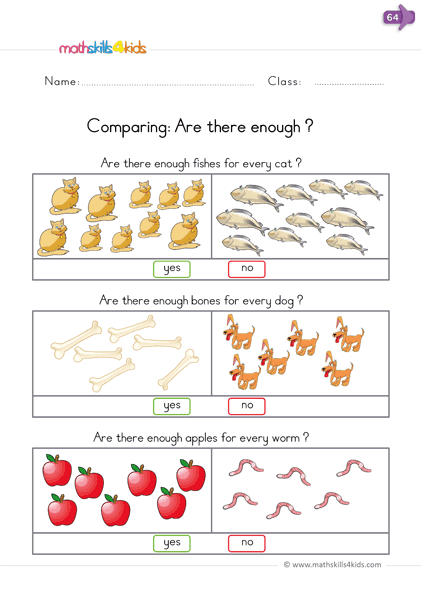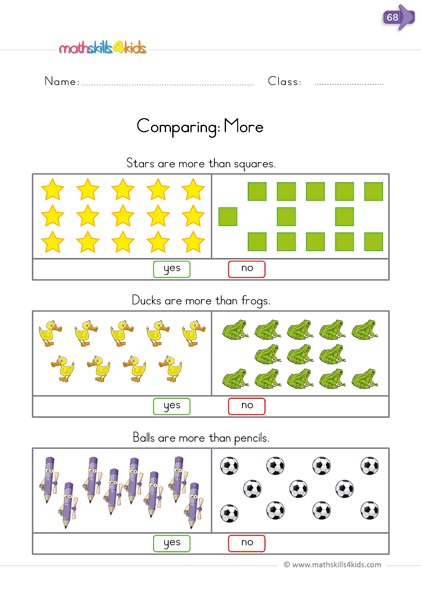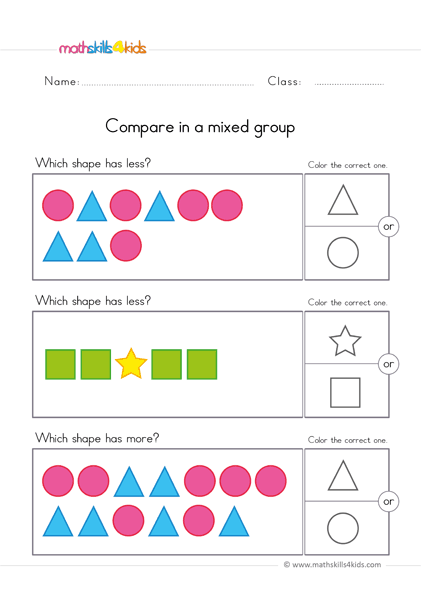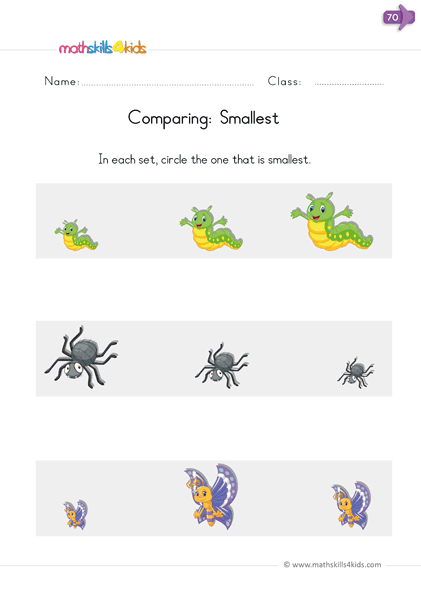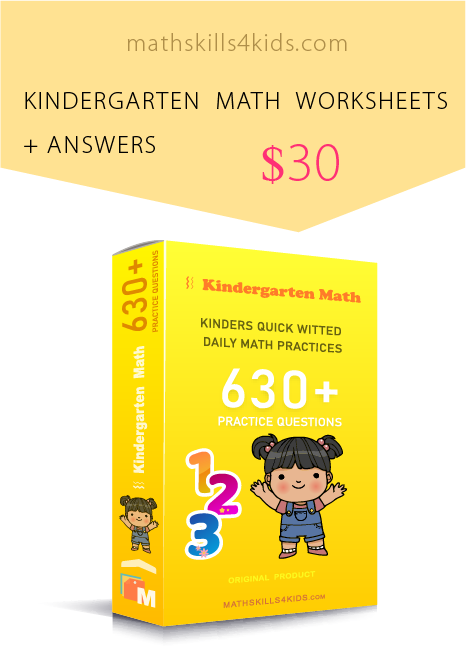Kindergarten comparison worksheets: numbers vs. sizes
If you are looking for fun and engaging worksheets to help your kids learn how to compare numbers and sizes in kindergarten, you have come to the right place! Here are some fantastic kindergarten comparison worksheets that will make your kids love math and develop their critical thinking skills.
-
In this comparing numbers and sizes concept, kids will observe the properties of different objects or things, then relate them to each other using comparison words. On the other hand, they will compare numbers according to their values and identify the smaller and bigger numbers using comparison signs.
How to teach your kids to compare numbers and sizes in kindergarten
One of the best ways to teach your kids to compare numbers and sizes is to use concrete objects they can see, touch, and manipulate.
For example, you can use blocks, toys, fruits, or anything else of interest to your kids. You can ask them to sort the objects into groups based on size, shape, color, or quantity.
You can also ask them to arrange the objects from smallest to largest or from least to greatest. You can challenge them to find an object that is bigger than another or has more than another object.
You can also use comparison words like bigger, smaller, more, less, same, different, etc., to help them express their comparisons.
In the following lines, you'll find ideas on strategies and materials that you can use with children for comparison.
-
BROWSE THE WEBSITE
-
DOWNLOAD FREE WORKSHEETS
-
-
K- MATH TOPICS
- Learn to count up to 3
- Counting from 1 to 5
- Count up to 10
- Learn to count up to 20
- Counting to 100
- Skip counting
- Measurement
- Sum and difference
- Comparison
- Patterns
- Addition up to 5
- Addition up to 10
- Subtraction up to 5
- Subtraction up to 10
- 2D shapes
- Introduction to symmetry
- Position
- Fractions
- Time
- Classify
- Data and graph
- Probability
- 3D shapes
-
-
Introduction to comparisons
Before introducing the concept of comparing numbers and sizes kindergarteners, ensure that they have a thorough mastery of numbers and their meanings, likewise objects with different properties.
Why is comparison necessary for kindergarteners?
Comparisons are a way of expressing how two or more things are similar or different in some aspect. For example, we can compare the height, weight, color, shape, or quantity of objects.
Comparisons help kids understand the concept of measurement, which is essential for math and science. Comparisons also help kids develop their vocabulary, logic, and reasoning skills.
-
Comparing Numbers
One of the first types of comparisons that kids learn in kindergarten is comparing numbers. Comparing numbers means determining which number is bigger or smaller than another number.
For example, we can compare 3 and 5 by saying that 3 is less than 5 or 5 is greater than 3. From this example, you can see that comparing numbers practice will significantly enhance your kids' number sense skills in no time, i.e., quickly noticing that some numbers represent larger quantities than others.
In addition, comparing numbers helps kids learn the order of numbers, which is essential for counting and arithmetic.
The three unique comparison signs your kids will use to compare these numbers are < = >, which stands for: < (less than) = (equal to) > (greater than)
-
Comparing Sizes
Another type of comparison that kids learn in kindergarten is comparing sizes.
Comparing sizes means determining which object is bigger or smaller than another in terms of length, width, height, area, or volume.
For example, we can compare a pencil and a ruler by saying that the pencil is shorter than the ruler or the ruler is longer than the pencil.
Comparing sizes helps kids learn the concept of measurement units, such as inches, centimeters, feet, meters, etc.
-
Mixed Comparisons
Once kids master comparing numbers and sizes separately, they can move on to mixed comparisons. Mixed comparisons mean comparing two or more things using both numbers and sizes.
For example, we can compare a cup and a bowl by saying that the cup has less water than the bowl or the bowl has more water than the cup.
Mixed comparisons help kids integrate their knowledge of numbers and sizes and apply it to real-life situations.
Also, your kids will enjoy having fun while learning.
-
Challenge comparisons
If your kids are ready for some extra challenge, you can try some challenge comparisons. Challenge comparisons mean comparing two or more things using more than one aspect or criterion.
For example, we can compare a triangle and a square by saying: “the triangle has fewer sides than the square but more angles than the square.”
Challenge comparisons will help kids develop their higher-order thinking skills and creativity.
The best way for kids to develop their skills in comparing is through illustrations and fun. Hence we will take the stress out on kids by designing colorful pictures with different attributes.
-
Kindergarten numbers comparison vs. sizes comparison
Now that you have learned about the different types of comparisons that kids can learn in kindergarten, let me show you some awesome kindergarten comparison worksheets you can download and print for free!
These worksheets are designed to help your kids practice comparing numbers and sizes in a fun and interactive way. They include colorful pictures, cute characters, and engaging activities to motivate and interest your kids.
The worksheets are divided into different sections: your kids or students must learn through the introduction to comparisons, comparing numbers, comparing sizes, mixed comparisons, and challenge comparisons.
Each section has four worksheets that cover different skills and concepts related to comparisons. You can use these worksheets as homework assignments, classwork activities, or assessment tools. You can also customize them according to your kids' needs and preferences.
Excellent math proficiency – kinders comparison strategy
The many activities designed in our Comparison worksheets for kindergarten, are meant to offer kids an excellent math proficiency. One of such activity is comparing: are there enough?
The kinders comparison strategy which will be used here will be a one-to-one match of number of food to number of animals, to see if the food will actually be enough for all the animals. This exercise requires just a “Yes” and “No” answer
In addition to these exquisite and awesome compare numbers and sizes activities, there is the exercise comparing: smallest. The understanding of this concept is based on the fact that each set of objects is presented with three objects of varying sizes, from small, to smaller, and to smallest.
Presenting objects in varying sizes will foster your kids understanding of future measurement lessons. This worksheet will however introduce kids to comparative adjectives- small, smaller, and smallest. Nonetheless, the objective of this concept is for kids to identify the object with the smallest size.
Example: in each case, circle the one that is smallest
It’s very easy to identify the smallest bee. This is because the difference in their sizes is very clear. Following in each case, circle the one that is smallest, kids are meant to circle only the object that is very tiny compared to the others, such as →

This is great. Yes! The second bee is very very tiny. Of course, that’s the smallest.
-
Thank you for sharing the links of MathSkills4Kids.com with your loved ones. Your choice is greatly appreciated.
We hope you enjoy these kindergarten comparison worksheets as much as I do! They are a great way to help your kids learn how to compare numbers and sizes in kindergarten and have fun at the same time.
Happy comparing!
Useful links
Comparing Sets Worksheets for Kindergarten | A Wellspring:
https://www.awellspringofworksheets.com/subjects/math/comparing-sets/
Comparing Numbers Worksheets | K5 Learning:
https://www.k5learning.com/free-math-worksheets/topics/comparing-numbers
